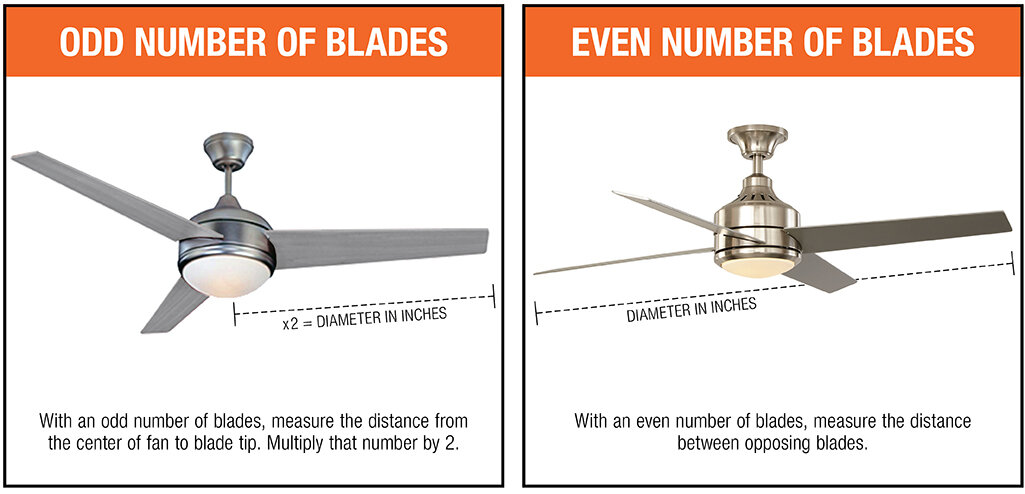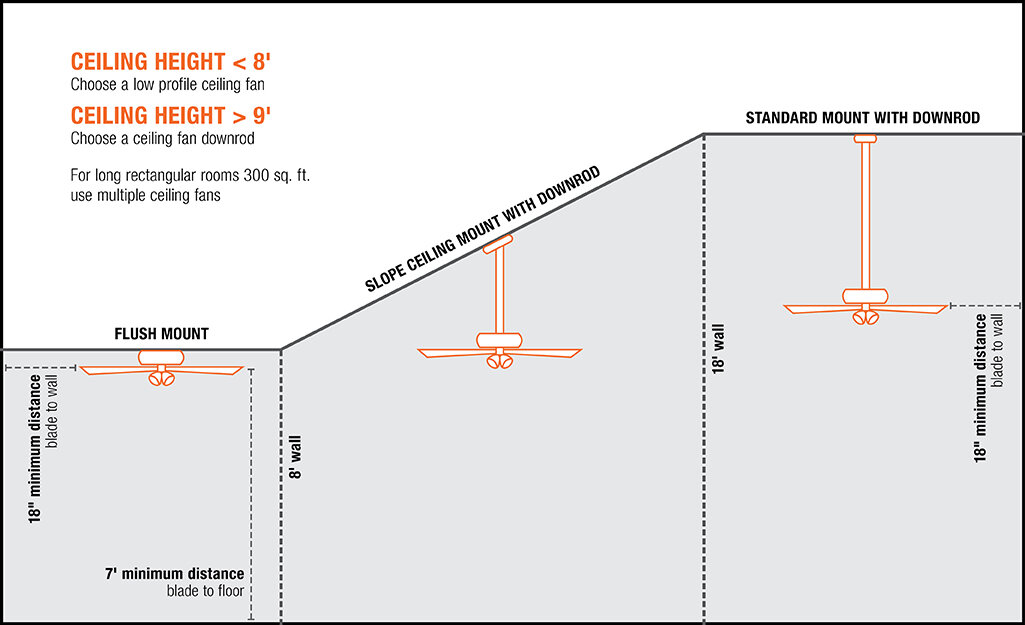How to Measure for a Ceiling Fan
Ceiling fans can be crucial for cooling your home or circulating air in a stuffy room while also providing a dynamic fixture for decoration. If you want to install a new ceiling fan or replace an old one, you need to select the right size fan for the size of the room. This guide reviews how to measure for a ceiling fan and choose between the different ceiling fan types.
How to Measure a Room's Square Footage
Begin to determine your needed ceiling fan size by calculating the square footage of the room. It’s easy to measure a rectangular room to determine its square footage.
Extend a tape measure from one wall to the opposite wall to determine the length.
Then measure the width of the room using the same method.
Multiply the length times the width to determine the room’s square footage. For example, a 12- by 15-foot room will have a square footage of 180 feet.
If your room has an “L” shape, simply divide the room into two rectangles. Determine the square footage of each rectangle by the above method and then add those results together.
How to Measure a Ceiling Fan
You may need to know how to measure a ceiling fan to determine its span or sweep, which is the same as the diameter of the fan.
If necessary, turn the fan off and wait for it to stop spinning before measuring.
Standing on a step ladder as needed, hold one end of a tape measure to the tip of a fan blade on a fully assembled fan.
If the unit has an even number of ceiling fan blades, extend the tape measure to the end of the opposite blade and record the distance from tip to tip. This is the diameter.
If the unit has an odd number of ceiling fan blades, such as a five-blade fan, measure from the tip of a blade to the center of the fan to determine the radius. Then double that amount to determine the diameter.
Compare the fan blade sweep, or diameter, to the room’s square footage to determine the right ceiling fan for your room.
Install a fan with a 42-inch sweep in rooms up to 144 feet.
Install a fan with a 44-inch sweep in rooms from 144 to 225 feet.
Install a fan with a 52-inch sweep in rooms from 225 to 400 feet.
Larger rooms may need more than one fan.
Tip: Ceiling fan blades should be at least 18 inches from the walls. If there isn't enough clearance between the blades and the walls, air will not circulate efficiently. This keeps the room from getting as cool as needed.
How to Determine the Height of a Ceiling Fan
Another factor in how to measure for a ceiling fan is determining how low the fan will hang. If your room has a low ceiling, a fan that hangs too low runs a greater risk of hitting a tall person. In addition. ceiling fans are recommended to have at least eight inches of clearance between the blades and the ceiling for optimal air flow.
If necessary, use a tape measure to determine the room’s ceiling height. You may need a helper and a step ladder.
Ceiling fans are recommended to be placed no less than seven feet above the floor. If the ceiling height is less than eight feet, choose a low-profile ceiling fan. Low profile ceiling fans are designed for the blades to be closer to the ceiling than standard ceiling fans.
For ceilings that are seven feet or close to it, consider flush mount ceiling fans, a type of low profile ceiling fan designed for the base to be anchored flush with the ceiling. Some of the models are nicknamed “ceiling hugger fans” and may not be able to generate as much air flow as standard fans.
How to Determine Downrod Length
If the room has a high ceiling of greater than 9 feet, choose a downrod ceiling fan.
Downrods are metal extension rods that connect the fan’s motor housing to the mounting hardware. They are used both to stabilize a fan and lower the fan so it hangs at an optimal height for air circulation, around 8 to 9 feet.
Most fan housings have a height of between 8 and 12 inches, so if you want to hang a 12-inch fan from a 10-foot ceiling, you’ll need a 12-inch downrod for it to hang at 8 feet.
See the chart to compare ceiling heights to downrod lengths.
Other Factors for Choosing a Ceiling Fan
You may need to consider these additional factors when determining the ceiling fan you need.
Many models of ceiling fan have lights installed. When determining the height of the fan itself, expect the light kit to add more additional inches and include those in your calculation. You may need to measure the height of the fan itself.
If the ceiling has an angle of 34 to 56 degrees, it will need a slope mount or angle mount ceiling fan.
Make sure you mount the fan to an area of the ceiling that will support its weight.
Make sure there are no obstacles on the ceiling that could impede the blades.
Learning how to measure for a ceiling fan involves determining the important factors that influence fan size, including the square footage of the room, the height of the ceiling, the span of the ceiling fan and the length of the downrod. Choosing the best ceiling fan size for your room can ensure that you can keep things cool.
Need help identifying a ceiling fan? Find products fast with image search in The Home Depot Mobile App. Snap a picture of an item you like and we'll show you similar products.




